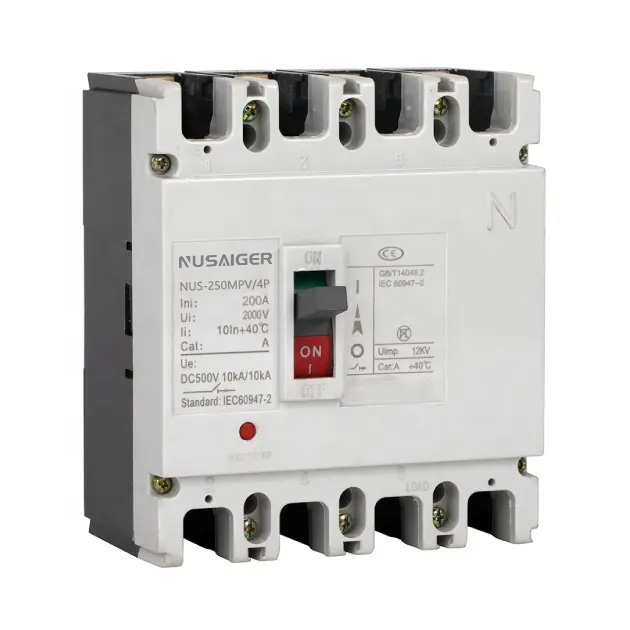DC MCCB Maintenance and Troubleshooting: Ensuring Reliability in Solar and Energy Storage Systems
1. Why Maintenance of DC MCCBs Matters
DC molded case circuit breakers are critical safety devices. Their failure can lead to arc faults, fire hazards, or unplanned downtime—especially in high-voltage DC environments like PV and ESS. Regular maintenance helps prevent nuisance trips, ensures breaking capacity, and maintains proper arc suppression performance. Well-maintained breakers contribute to grid safety and long-term reliability.
2. Maintenance Schedule and Checklist
A recommended maintenance schedule includes quarterly visual inspections and annual comprehensive testing. Basic checks include torque validation of terminals, SPD integrity, arc chute condition, mechanical operation, insulation resistance readings, and thermal imaging to detect hotspots.
3. Visual Inspection Guidelines
Visual inspection should cover: enclosure seals, physical damage, corrosion on terminals or arc chutes, discoloration indicating overheating, proper cable strain relief, and intact rating labels. Any sign of moisture ingress requires immediate drying and resealing.
4. Thermal Imaging and Hot Spot Analysis
A thermal camera helps identify overloaded connections or loose terminals by highlighting temperature anomalies. Even a few degrees above room temperature can indicate a potential failure point. Thermal scans should be conducted under load conditions and compared across identical poles.
5. Insulation Resistance Testing
Measure insulation resistance between DC poles and between each pole and ground using a megohmmeter. Values should meet manufacturer specs (typically ≥ 100 MΩ). Low readings may indicate moisture damage, internal tracking, or degraded insulation.
6. Mechanical Operation and Trip Testing
Operate the breaker manually to ensure smooth opening and closing. Test trip functions—overload, short circuit, and remote trip (if available)—using test tablets or simulated current injections. Confirm that trip thresholds match settings and breaker actuates cleanly.
7. Arc Chute and Contact Maintenance
Arc chutes must be clean and undamaged to extinguish arcs properly. Inspect contacts for pitting or burn marks, which indicate excessive arcing. Replace parts based on wear guidelines—most manufacturers recommend inspection after 10,000 operating cycles or every 5 years.
8. SPD Integration and Function Checks
Surge protection devices connected to DC MCCBs should be visually inspected and tested. Replace SPD modules that have tripped or show degraded protection levels. Ensure ground connections remain low impedance.
9. Common Failures and Troubleshooting Examples
Typical issues include: breaker not resetting after trip, uneven heat distribution among poles, remote trip failure, stationary contact wear, or nuisance trips due to incorrect curve selection. Troubleshooting requires methodical diagnosis—validate wiring, verify ambient derating, and check coordination with upstream protection.
10. Case Study: Solar Farm Breaker Failure and Resolution
In a 20 MW solar farm, breakers in one set of AC/DC combiner boxes began overheating under high afternoon ambient temperatures. Thermal imaging revealed one pole consistently 15 °C hotter. After reseating and retightening terminal connections, the temperature normalized and failures ceased.
11. Toolkits and Equipment for Maintenance
Essential tools include: insulated torque drivers, thermographic camera, megohmmeter, current injection testers, spare arc chutes/contacts, cleaning sprays recommended by breaker manufacturers, and PPE for high-voltage DC environments.
12. Documentation and Compliance
Maintain a log of all maintenance activities with dates, measured values, photos, and technician signatures. Such records support warranty claims, certifications, and insurance audits, demonstrating compliance with maintenance standards like IEC 60364‑7‑712 and UL requirements.
13. Extending Service Life with Smart Features
Smart DC MCCBs with integrated sensors allow remote monitoring of trip history, temperature, current, and humidity. Alerts for abnormal patterns can trigger proactive maintenance—reducing unplanned downtime and improving operational efficiency.
14. Best Practices and Avoiding Mistakes
- Never skip trip testing—sit idle breakers can fail when overloaded.
- Avoid overtightening terminals—follow torque spec accuracy.
- Don’t expose breakers to moisture—seal enclosures after maintenance.
- Use manufacturer-approved parts only.
- Account for derating factors in hot or high-altitude environments.
15. Conclusion
Routine maintenance and correct troubleshooting of DC MCCBs are key to long-term solar and energy storage system reliability. A structured maintenance program, coupled with preventive diagnostics, can significantly reduce risk and ensure uninterrupted operation.



